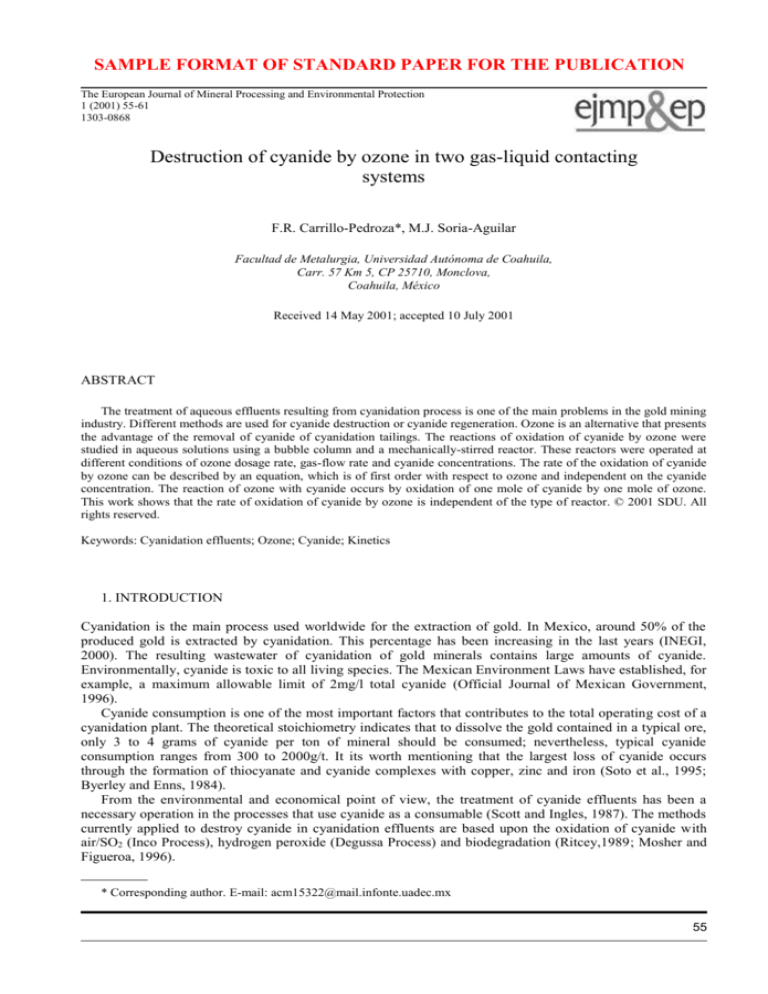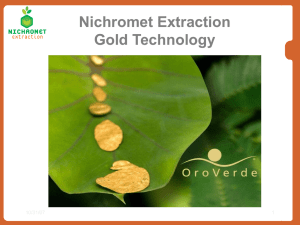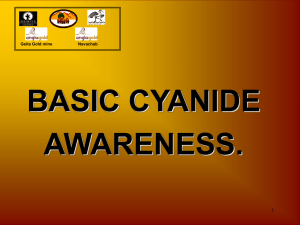
SAMPLE FORMAT OF STANDARD PAPER FOR THE PUBLICATION
The European Journal of Mineral Processing and Environmental Protection
1 (2001) 55-61
1303-0868
Destruction of cyanide by ozone in two gas-liquid contacting
systems
F.R. Carrillo-Pedroza*, M.J. Soria-Aguilar
Facultad de Metalurgia, Universidad Autónoma de Coahuila,
Carr. 57 Km 5, CP 25710, Monclova,
Coahuila, México
Received 14 May 2001; accepted 10 July 2001
ABSTRACT
The treatment of aqueous effluents resulting from cyanidation process is one of the main problems in the gold mining
industry. Different methods are used for cyanide destruction or cyanide regeneration. Ozone is an alternative that presents
the advantage of the removal of cyanide of cyanidation tailings. The reactions of oxidation of cyanide by ozone were
studied in aqueous solutions using a bubble column and a mechanically-stirred reactor. These reactors were operated at
different conditions of ozone dosage rate, gas-flow rate and cyanide concentrations. The rate of the oxidation of cyanide
by ozone can be described by an equation, which is of first order with respect to ozone and independent on the cyanide
concentration. The reaction of ozone with cyanide occurs by oxidation of one mole of cyanide by one mole of ozone.
This work shows that the rate of oxidation of cyanide by ozone is independent of the type of reactor. © 2001 SDU. All
rights reserved.
Keywords: Cyanidation effluents; Ozone; Cyanide; Kinetics
1. INTRODUCTION
Cyanidation is the main process used worldwide for the extraction of gold. In Mexico, around 50% of the
produced gold is extracted by cyanidation. This percentage has been increasing in the last years (INEGI,
2000). The resulting wastewater of cyanidation of gold minerals contains large amounts of cyanide.
Environmentally, cyanide is toxic to all living species. The Mexican Environment Laws have established, for
example, a maximum allowable limit of 2mg/l total cyanide (Official Journal of Mexican Government,
1996).
Cyanide consumption is one of the most important factors that contributes to the total operating cost of a
cyanidation plant. The theoretical stoichiometry indicates that to dissolve the gold contained in a typical ore,
only 3 to 4 grams of cyanide per ton of mineral should be consumed; nevertheless, typical cyanide
consumption ranges from 300 to 2000g/t. It its worth mentioning that the largest loss of cyanide occurs
through the formation of thiocyanate and cyanide complexes with copper, zinc and iron (Soto et al., 1995;
Byerley and Enns, 1984).
From the environmental and economical point of view, the treatment of cyanide effluents has been a
necessary operation in the processes that use cyanide as a consumable (Scott and Ingles, 1987). The methods
currently applied to destroy cyanide in cyanidation effluents are based upon the oxidation of cyanide with
air/SO2 (Inco Process), hydrogen peroxide (Degussa Process) and biodegradation (Ritcey,1989; Mosher and
Figueroa, 1996).
* Corresponding author. E-mail: acm15322@mail.infonte.uadec.mx
55
F.R. Carillo, M.J. Soria / The European Journal of Mineral Processing and Environmental Protection
1 (2001) 55-61
1303-0868
Ozonation is a promising technology to treat cyanide effluents. It is a strong oxidant and produces nontoxic products. According to the literature, the oxidation of cyanide with ozone occurs fast and is most
probably limited by the transport of the gas to the aqueous phase (Khandelwal et al., 1959; Mathieu, 1977;
Zeevalkink et al., 1980; Gurol et al., 1984; Ilie et al., 1998).
The objective of the present study is to generate fundamental knowledge on the kinetics and mechanisms
of the reaction of ozone with cyanide. Also, the effect of the type of reactor or liquid-gas contacting system
upon the transfer of ozone to the aqueous phase is to be addressed, and parameters such as ozone
consumption and stoichiometric relations among reactants and products are to be evaluated.
2. EXPERIMENTAL
2.1. Apparatus
The experimental setup consisted of a conventional bubble column, see Figure 1, (0.057m diameter and
1.8m height) equipped with a sparger (2mm pore size, 0.02m diameter and 0.027m height) located at the
bottom of the column. A second reactor which is a mechanically-stirred cell, see Figure 2, (0.2m diameter
and 0.2m height) also equipped with a sparger (2µm pore size, 0.02m diameter and 0.027m height), and an
ozone generator (Pacific Ozone L22) was used. On-line monitoring was performed for the solution pH (Orion
SA520), oxidation-reduction potential (ORP, Orion 520-A, Au vs. Ag/AgCl with temperature sensor),
dissolved-ozone (ATI A15/64).
2.2. Procedure
Tests were performed in each reactor by bubbling an oxygen-ozone mixture through 2.7 liter of solution
for a given period of time. Ozone was produced from pure oxygen and its concentration was controlled by
manipulating the intensity of the electric current and the flow rate of oxygen fed to the generator.
Figure 1. Bubble column reactor
56
F.R. Carillo, M.J. Soria / The European Journal of Mineral Processing and Environmental Protection
1 (2001) 55-61
1303-0868
Figure 2. Mechanically-stirred reactor
Ozone concentration in the gas phase was analyzed by means of the iodometric method while ozone in
solution was monitored by using a dissolved-ozone electrode.
Experiments to study the reaction of ozone with cyanide were performed at different ozone
concentrations in the gas phase and cyanide initial concentration in the aqueous phase.
The pH of the solution was fixed in a value of 10, similar at industrial solutions. Cyanide was analyzed
both by titration with silver nitrate and with the help of a cyanide-specific electrode. Ammonia electrode was
used for determining cyanate.
3. RESULTS AND DISCUSSION.
The cyanide oxidation was studied in the two reactors: a mechanically-stirred reactor and a bubble
column. In these tests, a solution of NaCN at an initial pH of 10, containing 200 to 750mg/l cyanide was
used.
Figure 3 shows the oxidation of cyanide by ozone using the bubble column, at room temperature. This
figure also shows measures of pH, redox potential and dissolved ozone.
It is observed that as long as cyanide is present in solution, redox potential, dissolved ozone and pH
values remain nearly constant. When cyanide is completely oxidized these parameters change: Redox
potential increases to around 600mV, pH slightly decreases (probably due the fact that the solution is not
buffered), and dissolved ozone starts to drift, which indicates that other ozonation reactions, such as cyanate
and ammonia oxidation, are taking place.
It is worth noting in Figure 3 that the evolution of redox potential is closely related to the evolution of
cyanide concentration, suggesting cyanide oxidation may be followed and manipulated by using a redox
potential control loop both to the complete destruction of cyanide and to optimize the ozone consumption.
According to equation 1, the product of cyanide oxidation is cyanate:
CN O3 CNO O2
(1)
57
F.R. Carillo, M.J. Soria / The European Journal of Mineral Processing and Environmental Protection
1 (2001) 55-61
1303-0868
Figure 3. Cyanide ozonation, T=27oC, Fg=4l/min, Vsg=2.92cm/s, Vsl=1.4l/min, VaO3g=0.068g/min
In order to determine whether that all ozone added is consumed by the cyanide oxidation, as suggested by
the behavior of dissolved ozone in Figure 3, a recipient containing a KI solution was installed in the exhaust
gases.
Ozone analyzed by iodometric method was not detected during cyanide destruction. According to this, as
shown in Figure 4, ozone consumption is 1.85gram of ozone per gram of cyanide in solution, this number
being independent of cyanide concentration and ozone addition rate (in the range of 0.06 at 0.14g/min). From
a balance of cyanide, it becomes apparent that one mole of cyanide is oxidized by one mole of ozone to
produce one mole of cyanate, as indicated by the stoichiometry of reaction.
Figure 4. Ozone consumed for cyanide oxidation at different ozone addition rate and initial cyanide concentration
58
F.R. Carillo, M.J. Soria / The European Journal of Mineral Processing and Environmental Protection
1 (2001) 55-61
1303-0868
Figure 5. Cyanide oxidation with ozone, using the mechanically-stirred reactor. T=25oC, pH=10
The Figure 5 shows cyanide oxidation with ozone, using the mechanically-stirred reactor using a stir
speed of 500rpm, obtained of a preliminary mass transfer study (Carrillo et al, 1998).
It is observed that the oxidation of the cyanide is linear with regard to time and, therefore, independent of
the concentration of initial cyanide; for this reason, a solution with an initial cyanide concentration of
1040mg/l is destroyed at the same rate as that of a solution whose initial cyanide concentration is 450mg/l,
that is the rate of oxidation is 50.2mg/lmin. The figure also shows that the cyanide oxidation rate is enhanced
by increasing the ozone addition rate.
The observations realized for the Figure 5 are the same ones that can be observed for the results found in
the bubble column, Figure 6. In both figures, the cyanide oxidation is enhanced by increasing the ozone
addition rate and is not affected by the initial cyanide concentration in the solution. On the other hand,
cyanide decay linearly with time which means that cyanide oxidation rate is constant, that is to say, that
follows a zero order reaction where the cyanide destruction velocity increasing proportionally with the ozone
addition rate.
The data resulting obtained from the two reactors can be presented by a simple kinetics model. The
model, described by equation 2, fits the experimental data fairly well (correlation coefficient greater 98%).
The cyanide oxidation rate constant obtained is about 10 -5mol/ls, i.e., cyanide disappearance rate is in the
range of 15 to 26mg/lmin, for the ozone addition rates used in this work.
CN CN k t
0
(2)
1
It is interesting to observe that for both reactors there is no difference in the slopes of the curves, that
which indicates that the reactor type doesn't influence in the cyanide oxidation rate. Considering that the two
reactors do not affect the cyanide oxidation rate, this also can be calculated by means of the following
engineering relationship:
Oxidation rate, g/lmin=[190.53+/-15] [ozone addition rate, g/min]
(3)
59
F.R. Carillo, M.J. Soria / The European Journal of Mineral Processing and Environmental Protection
1 (2001) 55-61
1303-0868
The results obtained indicate that the oxidation of cyanide with ozone is a very fast chemical reaction,
where the ozone, when being absorbed in the solution, immediately reacts with the cyanide. Therefore the
restrictive step is the concentration of available ozone in the gas phase, and less depend on the hydrodynamic
characteristic of the reactors, or their transfer characteristics.
4. CONCLUSIONS
The reaction of ozone with cyanide at alkaline pH values is fast and controlled by ozone addition rate.
The oxidation of cyanide is a first order reaction with respect to ozone and zero order with respect to cyanide.
Ozone consumption data show that one mole of cyanide is oxidized by one mole of ozone to produce one
mole of cyanate. Oxidation of cyanide by ozone is faster than the oxidation of cyanate and consequently
cyanate remains in solution until cyanide is completely oxidized. Although two gas-liquid contacting system
were used, a bubble column and a mechanically-stirred reactor, the hydrodynamic factors of these reactors do
not affect the cyanide oxidation rate, because the mass transfer of ozone gas to the aqueous phase is fast and,
therefore, only the ozone concentration in gas is the limiting factor of the reaction.
ACKNOWLEDGEMENTS
The authors thanks to Universidad Autónoma de Coahuila for the financial support received.
NOMENCLATURE
CN:Concentration of cyanide in solution, mol/l
[CN-]
:Concentration of cyanide in the bulk solution, mol/l
[CN-]0
:Initial concentration of cyanide in solution, mol/l
CNO:Concentration of cyanate in solution, mol/l
Fg
:Flow gas rate, l/min
k1
:Cyanide destruction rate constant, mol/ls
O3
:Concentration of ozone dissolved, mol/l
O3g
:Concentration of ozone in gas, in weight percentage, %
ORP :Oxidation-reduction potential, mV
T
:Time, s
T
:Temperature, oC
Vsg
:Gas superficial velocity, cm/s
Vsl
:Liquid flow rate, l/min
VaO3g
:Ozone addition rate, g/min
REFERENCES
Byerley, J. and Enns, K., Electrochemical regeneration of cyanide from waste thiocyanate for cyanidation. CIM Bulletin,
1984, 87-93.
Carrillo P, F. R.., F. Nava A., A. Uribe S. R. Perez G y C. Lara V, Ozonation of cyanide-containing effluents: effect of
the hydrodynamics of the reactor on the Ozone transfer to the aqueous phase. Proceedings of the International
Conference on Clean Technologies for the Mining Industry, Vol 1, Santiago, Chile, May 13-15, 1998, pp. 247 -258.
Carrillo P, F. R., F. Nava A. y A. Uribe S., Gas-liquid reactors: a comparative study about the mass transfer and the gas
efficiency. Proceedings of the VIII International Congress in Extractive Metallurgy, I. P. N, Mexico, D. F., May 27 29, 1998.
Official Journal of Mexican Government, Mexican Law in Environment Protection, Octuber, 1996, 117.
60
F.R. Carillo, M.J. Soria / The European Journal of Mineral Processing and Environmental Protection
1 (2001) 55-61
1303-0868
Gurol, M. D., Bremen, W. M., Holden, T. E., Oxidation of cyanides in industrial wastewater’s by ozone. Conference on
Cyanide and the Environment Proceedings, Tucson, Arizona 1984, 341-361.
Ilie, P., Baciu,D., Mihaly, L., Morar, M. The kinetic of the ozonization process of cyan Ions from waste waters proceeded
from the processing of gold-silver ores. Proceedings of the 4th Conference on Environmental and Mineral Processing,
Czech Republic, 25 June 1998, 579-585.
Khandelwal, K. K., Barduhn, J., Grove, C. S., Kinetics of ozonation of cyanides. Ozone Chemistry and Technology.
Advances in Chemistry Series, American Chemical Society, 1959, 78-86.
Mathieu, G. I., Ozonation for destruction of cyanide in canadian gold mill effluents - a preliminary evaluation. CANMET
T Report 77-11, 1977, pp. 45.
Mosher, J. B. and Figueroa, Biological oxidation of cyanide: a viable treatment option for the minerals processing
industry?. Minerals Engineering, 9, 5, 1996, 573-581.
Ritcey G.M. Problems and solutions in the mining industry. Tailings Management, Elsevier, Netherlands, 1989.
61






